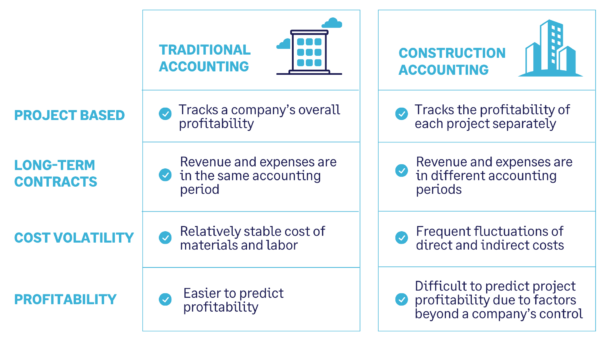The Future of Construction Accounting: Trends and Innovations to Watch
The Future of Construction Accounting: Trends and Innovations to Watch
Blog Article
A Comprehensive Guide to Construction Accountancy: Enhance Your Financial Administration
Effective financial monitoring is essential in the building and construction sector, where the intricacies of project-based income and expenses can significantly influence general success. By employing ideal methods in monetary reporting and evaluation, stakeholders can not only boost functional effectiveness but additionally alleviate potential threats.
Comprehending Construction Audit
Comprehending construction audit is important for the successful administration of funds in the building sector. This specific branch of audit addresses the special challenges dealt with by construction companies, consisting of project-based profits acknowledgment, expense monitoring, and compliance with regulatory requirements. Unlike typical bookkeeping, building and construction bookkeeping calls for a distinct technique to manage the complexities connected with long-term contracts and rising and fall costs.
Secret parts of construction accountancy consist of accurate income acknowledgment, which often depends on the percentage-of-completion technique or completed-contract approach, depending on the job's nature. This makes sure that economic statements reflect true performance and earnings with time. Furthermore, task costing plays an important role, enabling firms to track costs linked with details projects, which aids in identifying success and resource allotment.
An additional important aspect is the administration of capital, which is frequently affected by payment schedules and delays in receivables. Reliable capital administration guarantees that building companies can fulfill functional requirements and purchase future projects. Inevitably, understanding building accountancy gears up firms with the devices needed to make educated financial choices, alleviate risks, and boost general operational performance in an affordable industry.

Job Costing and Budgeting
Job costing and budgeting are essential components of construction accounting that make it possible for companies to successfully handle project funds and make certain earnings. Task costing entails the careful tracking of all costs associated with a certain job, including labor, products, devices, and overhead. This procedure allows construction firms to establish the true price of completing a job, promoting notified decision-making and enhancing monetary accountability.
Budgeting, on the various other hand, functions as an economic roadmap for jobs. It involves establishing financial restrictions and assigning sources to different task elements, thereby developing a framework versus which real expenses can be measured. Efficient budgeting calls for complete analysis and forecasting, taking into account historic data, market fads, and potential dangers.
Together, task setting you back and budgeting offer the essential tools for building companies to keep track of economic performance, determine differences, and adjust methods as required - construction accounting. By executing durable work setting you back techniques and adhering to well-structured budget plans, companies can enhance their functional effectiveness, alleviate economic risks, and ultimately improve their profitability in a competitive market. Therefore, these techniques are vital for sustaining long-lasting success within the building sector
Monitoring Expenses and Revenue
Precisely tracking costs and profits is essential for construction firms to preserve monetary health and wellness and linked here make sure task stability. Reliable monitoring permits organizations to monitor project performance, identify price overruns, and make educated economic choices. Applying an organized strategy to recording all financial purchases is crucial to achieving this objective.
Making use of building and construction accountancy software application can substantially improve the tracking process. These devices assist in real-time tracking of costs, including labor, products, and subcontractor prices, while likewise capturing revenue created from task turning points and client payments. By classifying costs and revenue streams, companies can obtain insights into productivity and cash money flow.

Financial Reporting and Evaluation
Monetary coverage and evaluation play a pivotal duty in the building and construction market, supplying stakeholders with crucial understandings into a company's monetary efficiency and operational performance. Precise economic reports, consisting of annual report, revenue statements, and capital declarations, are fundamental for examining the health of a building and construction business. These records help determine trends, assess task success, and promote informed decision-making.
In building accounting, monetary evaluation exceeds simple coverage; it involves inspecting economic data to discover underlying patterns and Website abnormalities. Trick performance signs (KPIs), such as gross earnings margins, task completion rates, and roi, work as benchmarks to assess functional success. Routinely examining these metrics permits companies to identify areas needing enhancement, maximize source allocation, and enhance job administration approaches.
In addition, reliable financial reporting fosters transparency and develops count on with stakeholders, consisting of customers, vendors, and capitalists - construction accounting. By keeping strenuous economic oversight, building and construction firms can mitigate risks, ensure compliance with regulatory requirements, and ultimately drive lasting development. Hence, a durable monetary coverage and analysis framework is important for navigating the complexities of the building and construction landscape and attaining lasting success
Finest Practices for Success
To accomplish success in building bookkeeping, companies must take on a collection of finest methods that improve operations and boost economic administration. Implementing a durable job monitoring software tailored for building can promote real-time tracking of job costs and spending plans, enabling for more precise forecasting and source allotment.
Second, embracing a consistent technique to job costing is critical. This includes diligently tracking all costs related to each project, including labor, products, and expenses. Frequently assessing job expenses versus initial quotes assists recognize variances early, allowing prompt rehabilitative actions.
Third, keeping strenuous documentation practices makes sure conformity with laws and streamlines audits. This consists of maintaining detailed records of contracts, change orders, invoices, and receipts.
Additionally, investing in personnel training is essential. Making certain that staff members are well-versed in accounting principles, software usage, and market standards can substantially enhance effectiveness and precision in monetary reporting.
Conclusion

Report this page